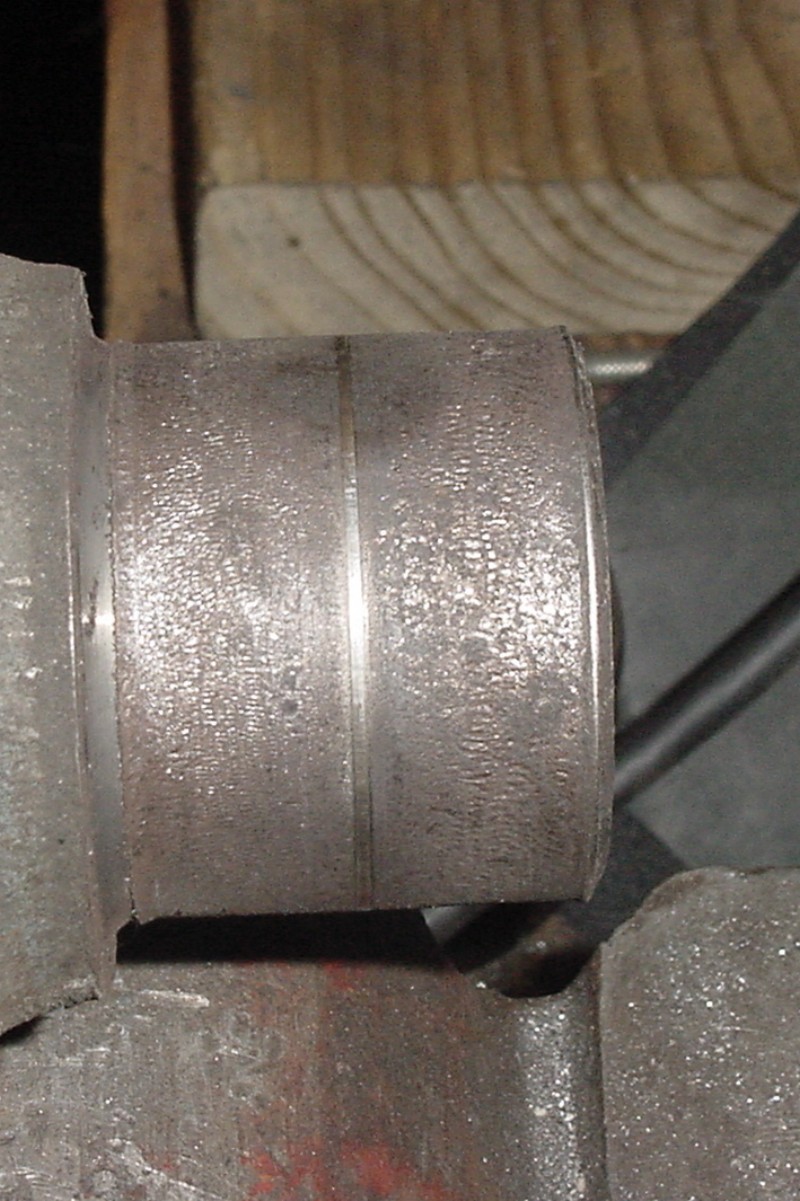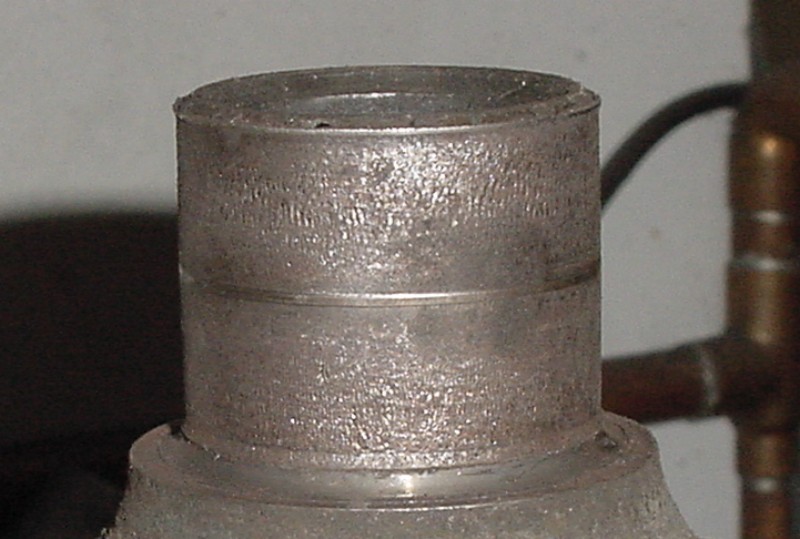|
|

|
Porsche, and the Porsche crest are registered trademarks of Dr. Ing. h.c. F. Porsche AG.
This site is not affiliated with Porsche in any way. Its only purpose is to provide an online forum for car enthusiasts. All other trademarks are property of their respective owners. |
|
|
  |
| John |
 Oct 7 2006, 08:46 PM Oct 7 2006, 08:46 PM
Post
#1
|
|
member? what's a member?     Group: Members Posts: 3,393 Joined: 30-January 04 From: Evansville, IN (SIRPCA) Member No.: 1,615 Region Association: None |
We were prepairing the track car for the last event of the season for us (in a couple weeks) and noticed one of the rear wheel bearings had given up the fight.
The wheel was very wobbly (could move it about 1/4" in most directions). We had not noticed this while driving at the last event, but we did notice that one or more of the brakes was dragging causing the brakes to fade after several hard laps. I had thought it was one of the front 930 calipers hanging up, but after finding this, I am almost certain that this was the problem. I removed the trailing arm and proceeded to remove the hub to find that the rear hub surface that holds the inner race was badly scored and pitted to the point that it is too far undersize to work with a new bearing. You can visually see where both inner bearing races eroded the outer hub. The inner surfaces of the inner bearing races show no signs of erosion, pitting, or scoring. This is not the condition that the hub was in when I assembled it. Has anyone heard of this happening? On another note, the bearing was a real pain in the ass to remove from the trailing arm (even with my 30 ton press) and I have never had that problem before even with nasty rusty trailing arms. Luckily, I have parts on hand to repair the car. I will try to post pics of the hub later tonight after I finish putting the car back together. I am assuming that somehow the inner races may have spun on the outer hub causing the erosion, but I have never witnessed this before. Anyone have some early 911 outer hubs they want to get rid of????? |
| PRS914-6 |
 Oct 8 2006, 08:01 AM Oct 8 2006, 08:01 AM
Post
#2
|
|
Excellence Magazine Project 914 3.6    Group: Retired Members Posts: 1,278 Joined: 20-May 06 From: Central California Member No.: 6,031 Region Association: None  |
John, that really puzzles me..... As you know, when the axle nut is tightened, the races are squeezed together by the step of the flanges. Only thing I can think of is the nut was not tight enough. Hard to believe with your obvious mechanical ability though. Was the press fit so tight that it may have squeezed the bearing down, reducing running clearance and generated more heat?
I think I have some 911 stub axles and hubs..... |
| Eric_Shea |
 Oct 8 2006, 10:33 AM Oct 8 2006, 10:33 AM
Post
#3
|
|
PMB Performance                Group: Admin Posts: 19,274 Joined: 3-September 03 From: Salt Lake City, UT Member No.: 1,110 Region Association: Rocky Mountains  |
I have a 914 hub that one of our fine patrons sent me as a core (IMG:style_emoticons/default/dry.gif)
I use it as a paperweight. It had the same issue. I've also had a control arm that was extremely difficult with the bearing... This sounds like a bad bearing/heat situation. They often don't show themselves because they are so tight until they fail. Other than that, I can't think beyond what Paul has mentioned with the 210ftlbs. on the nut. Is the mating flange on the 911 hub in good condition? I have a pair of early 911 hubs if you need them. Eric P.S. Maybe the 3.6 spun the axle/hub assembly faster than the bearing could keep up (IMG:style_emoticons/default/wink.gif) |
| John |
 Oct 8 2006, 11:16 PM Oct 8 2006, 11:16 PM
Post
#4
|
|
member? what's a member?     Group: Members Posts: 3,393 Joined: 30-January 04 From: Evansville, IN (SIRPCA) Member No.: 1,615 Region Association: None |
When installed afew years ago, the surface looked to be just fine and the fit was snug in the inner races of the bearings.
You can see from the pics exactly where the races were (even the space between the inner races is clearly shown in the pics. I don't have pics of the inner bearing races, but they were not scored. None of the scoring visable on the hub is visable on the bearing inner races. Thanks for the replys guys, and BTW, Ours is a 3.2 not a 3.6. Attached thumbnail(s)  Attached image(s) 
|
| PRS914-6 |
 Oct 8 2006, 11:29 PM Oct 8 2006, 11:29 PM
Post
#5
|
|
Excellence Magazine Project 914 3.6    Group: Retired Members Posts: 1,278 Joined: 20-May 06 From: Central California Member No.: 6,031 Region Association: None  |
John, pop the seals out of the bearings. Do the balls look like they seized up? Look blue? Set the balls on a white piece of paper for a color check.
I'm still thinking it was the press fit that caused a overheated bearing and a possible seizure and the hub had no choice but to spin in the race.....my humble guess anyway.... |
| John |
 Oct 9 2006, 09:20 AM Oct 9 2006, 09:20 AM
Post
#6
|
|
member? what's a member?     Group: Members Posts: 3,393 Joined: 30-January 04 From: Evansville, IN (SIRPCA) Member No.: 1,615 Region Association: None |
John, pop the seals out of the bearings. Do the balls look like they seized up? Look blue? Set the balls on a white piece of paper for a color check. I'm still thinking it was the press fit that caused a overheated bearing and a possible seizure and the hub had no choice but to spin in the race.....my humble guess anyway.... I was thinking along similar lines, but at first glance, I saw no pitting, bad spots, or discoloration in the bearing races (inner or outer). I will clean up the bearing parts in the parts washer, dry them off and take a couple pics tonight. I am kind of stumped on this one as there don't appear to be marks on the inner bores of the inner races. Just how hard are those races? Could this have occured from OVER TIGHTENING? What is the spec? I have been using 350# for years and not had a problem until now. |
| Eric_Shea |
 Oct 9 2006, 09:38 AM Oct 9 2006, 09:38 AM
Post
#7
|
|
PMB Performance                Group: Admin Posts: 19,274 Joined: 3-September 03 From: Salt Lake City, UT Member No.: 1,110 Region Association: Rocky Mountains  |
Could be... spec is #210
|
| John |
 Oct 22 2006, 09:36 PM Oct 22 2006, 09:36 PM
Post
#8
|
|
member? what's a member?     Group: Members Posts: 3,393 Joined: 30-January 04 From: Evansville, IN (SIRPCA) Member No.: 1,615 Region Association: None |
After completing this weekends track event, I believe that we have arrived at a reason behind the hub failure.
After about 4 laps on Friday (with new hub and wheel bearing in place) the car had HORRABLE vibrations under braking indicating a WARPED ROTOR. Inspecting all 4 rotors afterwards (when slightly cooled off), I found very little runout in all 4 of the rotors. I found no large cracks or any indication of overheating. We decided to haul the car back home to the shop to replace all 4 rotors with new ones we had bought over the past few years. After installing the new rotors (914-6 rear and 930 fronts), there was no vibration to be felt. In fact, the braking zones on the track seemed MUCH smoother than we had ever felt and the car stops exponentially better. We had been running with the 914-6 rotors for about 10 years with no apparent problems, but as it turns out, we feel that this has been an unknown issue for the past few years. The rotor (right rear) would only warp when it was heated up from some HOT laps. Our theory is that as the rotor would cause vibration, the caliper would try to hold it in place, the weakest link (the hub) would move to accomodate the vibration resulting in the pitted and displaced metal as shown in the picture above. The inner races did not spin on the hub as there is no wear on them, but rather, the inner races pressed dents into the hubs. Over time, this caused the wear that we found. To make a long story shorter, beware of warped rotors as they can cause damage far beyond an annoying pulsating brake pedal. I just don't know how to check for warpage when the rotors are HOT. Any ideas? |
  |
1 User(s) are reading this topic (1 Guests and 0 Anonymous Users)
0 Members:

|
Lo-Fi Version | Time is now: 9th May 2024 - 12:16 PM |
Invision Power Board
v9.1.4 © 2024 IPS, Inc.









